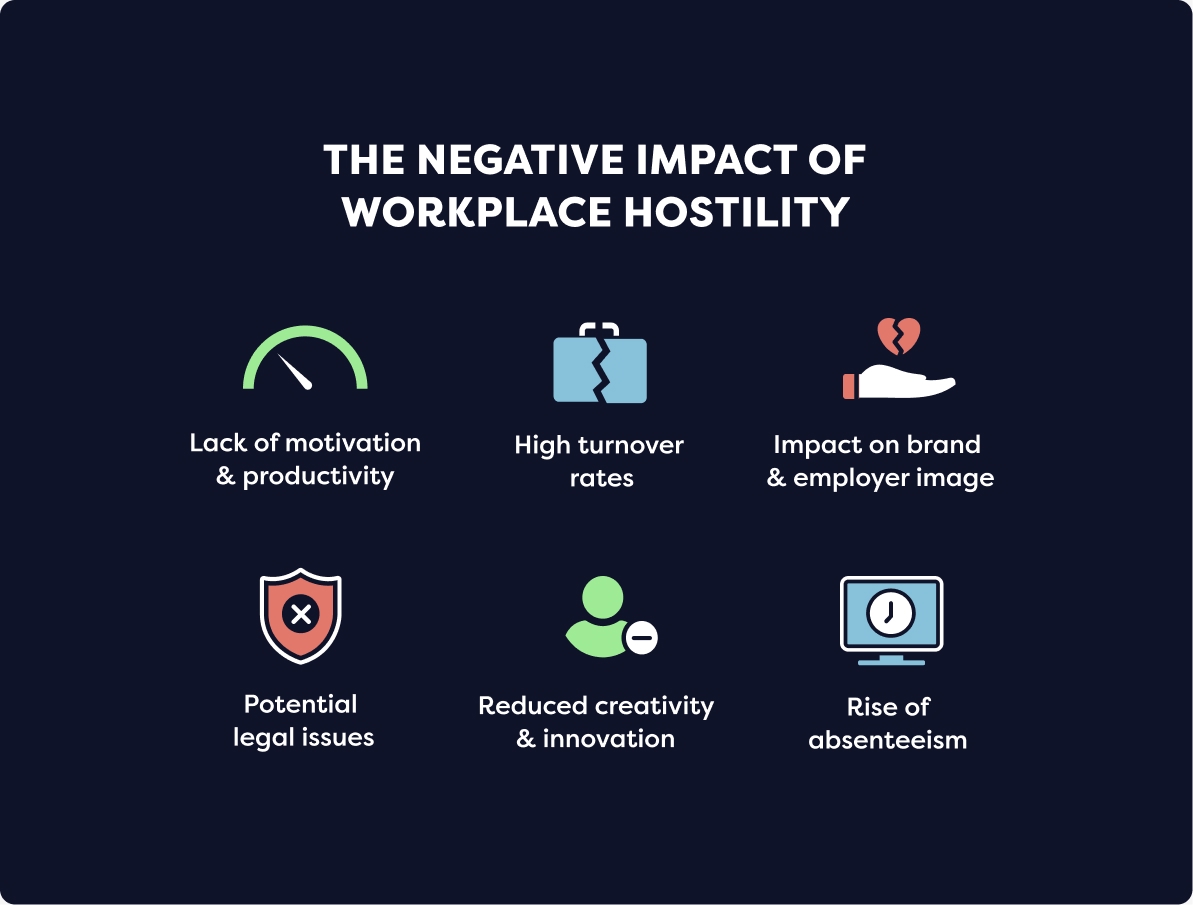Have you ever worked in a hostile environment, like 1 in 5 employees in the United States? If so, you already know the negative impact workplace hostility can have on motivation, productivity and workers’ personal lives.
Even if you have never been lucky enough to experience such situations, you can probably guess how workplace hostility can stifle employee engagement, innovation and overall business success.
What are the leading causes of hostility in the workplace, and how can you avoid such situations in your own company? We will cover these essential points in this article.
Main Causes of Hostility in the Workplace
Behind every workplace issue, there are underlying causes that HR managers and employers need to identify and solve. Here are the most common causes of workplace hostility.
Leadership Issues
If team leaders are the best equipped to deal with workplace issues, it is more often than not their inaction or negative practices that lead to workplace hostility. If managers are aware of interpersonal issues or hostile behaviors and do nothing about it, or if they don’t use the proper attitude to manage their teams, it negatively impacts the work environment. The HR department is also responsible for maintaining healthy relationships in the company, and their inaction or lack of awareness can cause hostility to develop.
Bad hiring practices
Hiring someone who presents toxic behaviors and struggles to communicate with their peers or fails to adhere to your company values can be the first step in the creation of a hostile work environment. This is why soft skills and culture-fit should be essential components of your hiring processes: they can help you avoid bad hires and preserve a healthy work environment.
Lack of culture-fit
Your current employees can also present issues of lack of culture-fit, thus affecting your work environment. If your company has undergone organizational and cultural changes over the past few years, some workers might struggle in adapting to these changes. Others might be disengaged and no longer feel like they are a part of the company culture. Whatever the situation may be, culture-fit is an essential part of a hostility-free workplace.
Frustrations in the workplace
Hostility can take a while before it is fully-fledged. It can start with “simple” frustrations with managerial practices, organizational decisions, business strategies or lack of professional development. Feelings of injustice and miscommunication can also lead to hostility over time. This is why noticing such issues is crucial to avoid hostile behaviors and situations.
5 Solutions for a Hostility-free Work Environment
Create a rock-solid employee handbook and code of conduct
The first step to eradicating workplace hostility is to create rules of conduct that will prevent hostile behaviors. They need to be extensive and communicated to all your teams, especially new hires so that everyone is on the same page. Reminders are also important if you notice that your code of conduct needs to be once again at the forefront of employees’ minds.
These rules also need to be included in your employee handbook. This will show that a healthy work environment is a top priority in your organization and that everyone needs to participate in creating a positive company culture. Create clear guidelines in case of non-compliance and misconduct so that hostile behaviors are addressed and solved right away.
Optimize your recruitment practices
Throughout your hiring process, you not only need to identify and evaluate hard skills, but also assess soft skills that will be essential to prevent hostility in the workplace. Communication skills, teamwork abilities and empathy are particularly important to ensure that your team builds and maintains healthy communication patterns in the long run.
Another essential aspect of recruitment practices is to assess culture-fit between the potential hire and your company values. By asking culture-fit questions during the interview, you will evaluate whether a candidate can relate to your company culture and fit in well with the rest of the team, thus ensuring that your workplace does not become hostile because of mis-hires.
Provide appropriate training to managers and employees
Managers and team leaders need to lead by example and help eradicate hostility in the workplace. In order to create the best conditions for healthy work environments, you need to train your managers on issues of hostility, discrimination and miscommunication in the workplace. By doing so, you will help them identify causes of hostility and solve them before they get out of control.
Employees also need to benefit from training opportunities, not only to identify hostility risks in their own team but also to prevent frustrations linked with career stagnation and lack of professional development. Remember to include all your workers in training efforts so that your entire organization feels like they are an integral part of your plan.
Promote communication and team spirit
Regular team meetings and team-building activities are crucial in promoting communication and team spirit on a daily basis. During these meetings and events, you need to encourage and highlight healthy discussions, constructive feedback and any effort that incites team cohesion.
If you notice any interpersonal issue arising, address it transparently and do everything in your power to solve it before it worsens. As a manager, HR professional or employer, your main role is to ensure that workflows and communication are smooth. Team cohesion is an essential component of productivity, engagement and healthy work habits and should be one of your top priorities.
Regularly survey your teams
Your teams need to be an integral part of healthy workplace habits. They also are the first to notice hostile behaviors or risks of unhealthy relationships. Therefore, you need to regularly collect their insights and ask them if your policies are effective and appreciated.
By getting your employees on board with your work environment policies, you ensure that they remain efficient and appropriate in the long run. Surveying your teams also provides opportunities to adjust your strategies if they are no longer effective and to notice challenges before they become full-blown issues.
A hostility-free workplace is essential to remain competitive, productive and innovative. By implementing these strategies for a healthy work environment, you will ensure that your employees remain happy, engaged and creative, which will ultimately lead to better performance and business results.



